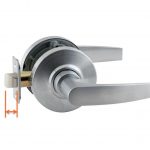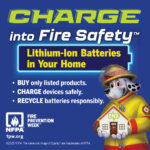When I teach classes about fire doors, one of the most common questions is regarding modifying fire doors in the field. NFPA allows limited modifications to be done in the field, and if doors are to be modified beyond what is allowed by NFPA 80, they are supposed to be taken back to a UL/WH shop, modified, re-labeled, and reinstalled. This made me wonder about the big hole left in the fire separation while the door is in the shop. Temporary doors aren’t feasible in most cases, because if you’re going to go to the trouble and expense of fitting a temporary door into an existing frame, you might as well just replace the existing door instead of modifying it. The answer might be to post a “fire watch” for the time period that the fire doors are removed.
Last week I read a discussion started by my pal Hal Kelton of DoorData Solutions, regarding the recommended procedures for a fire watch. And coincidentally, I also read about a huge fire in the Catskills (video below) where a fire watch was in place at the time of the fire due to problems with the fire doors, fire alarms, emergency lighting, and the sprinkler system. The fire was discovered by the fire watch and everyone was evacuated safely, but 7 of the 9 buildings in the complex were destroyed or damaged.
The 2009 International Fire Code defines a fire watch as:
A temporary measure intended to ensure continuous and systematic surveillance of a building or portion thereof by one or more qualified individuals for the purposes of identifying and controlling fire hazards, detecting early signs of unwanted fire, raising an alarm of fire and notifying the fire department.
Commentary: This term is used in several places throughout the code. A fire watch provides temporary fire safety where there are potential hazards, such as during hot work operations or when fire protection systems are out of service. A fire watch is not simply to watch for a fire but also to prevent fire by identifying and controlling fire hazards, such as the separation of combustibles from areas where welding is to occur. A fire watch also provides a method of notifying the fire department if a fire should occur.
The requirements for a fire watch vary depending on the purpose of the fire watch (hot work, public assembly, fire system deficiency, etc.), and many jurisdictions have their own requirements so it’s best to check with the local fire marshal before removing fire doors. A permit may be required.
Here’s an example of fire watch duties from the Sunnyvale, California Department of Public Safety:
Fire Watch is a temporary measure intended to ensure continuous and systematic surveillance of a building or portion thereof by one or more qualified individuals for the purpose of identifying and controlling fire hazards, detecting early signs of unwanted fire, raising an alarm of fire and notifying the fire department.
1. Conduct patrols of the entire facility/area every 15 minutes
2. Identify any fire, life or property hazard
3. Notify the Sunnyvale Department of Public Safety if a fire or other emergency is discovered by calling 911 or (408) 736-6244. The caller must be prepared to identify the type of emergency and provide an address and specific location.
4. Notify the occupants of the facility of the need to evacuate (notification devices or a public address function of an alarm system maybe used to assist in the evacuation of a building).
5. Establish and maintain at least one method of direct communication with the Public Safety Department. A telephone is acceptable.
6. Maintain a written log of fire watch activities. The log should contain the following:
A) Address of facility
B) Times that the patrol completed each inspection tour
C) Name of the person conducting the fire watch
D) Any communication to Sunnyvale Department of Public Safety
7. Fire Watch personnel shall have some form of visible identification; nametag with “Fire Watch”, vest, or other visible identification.
8. Fire Watch personnel should not perform firefighting duties beyond the scope of an ordinary person.
You need to login or register to bookmark/favorite this content.






Unforuantly with existing buildings life safety devices are going to be out of service, sometimes for a short time sometimes for days.
Depending on the problem and ahj sometimes dictates what means are put in place to make the building as safe as possible
Unforunatly “Murphy” sometimes takes this time to visit.
Good information, Lori. Thanks to Hal and your site, I am adding this information to my “Preparing Your Facility For Fire Door Inspections” class. Thankfully, the AHJ in Loch Sheldrake, NY Knew about the need for posting a firewatch in emergency situations.
Lori….
You are so correct when you advise people to consult their local AHJ on fire watches. In my experience, while most local AHJs permit the owner of the building to conduct their own fire watch, there are some local AHJs, in Massachusetts especially, that will only permit off-duty fire fighters to perform constant 24-hour/per day surveillance. This means the building owner must hire the firemen to constantly patrol the areas affected by the fire watch, as long as the deficiency remains. Not a cost-effective proposition.
Also, for those who may seek additional information on fire watches, I suggest they consider NFPA 241 ‘Standard for Safeguarding Construction, Alteration, and Demolition Operations’ and NFPA 601 ‘Standard for Security Services in Fire Loss Prevention’ for guidance.
Thank you…
Thanks Brad. I looked through several codes and standards trying to find the requirements for a fire watch. I’ll check NFPA 241 and 601.
The healthcare areas where I work that are affected get Interim Life Safety Measures issued along with documented training for the staff.
Automatic early warning system requires fire alarm, sprinkler, fire pump, etc. This is a good post by the way – very informative and detailed.
————–
fire protection systems